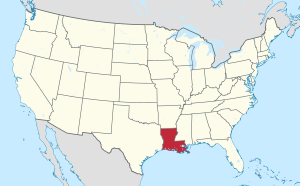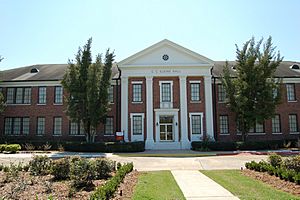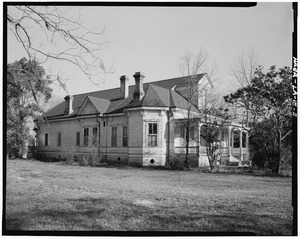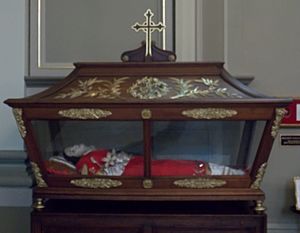Thibodaux, Louisiana facts for kids
Quick facts for kids
Thibodaux, Louisiana
|
|
|---|---|
| City of Thibodaux | |

Downtown
|
|
| Nickname(s):
Queen City of Lafourche
|
|

Location of Thibodaux in Lafourche Parish, Louisiana.
|
|

Location of Louisiana in the United States
|
|
| Country | United States |
| State | Louisiana |
| Parish | Lafourche |
| Incorporated | 1830 |
| Named for | Henry S. Thibodaux |
| Area | |
| • City | 6.79 sq mi (17.59 km2) |
| • Land | 6.79 sq mi (17.59 km2) |
| • Water | 0.00 sq mi (0.00 km2) |
| Elevation | 13 ft (4 m) |
| Population
(2020)
|
|
| • City | 15,948 |
| • Density | 2,348.06/sq mi (906.58/km2) |
| • Metro | 208,178 |
| Time zone | UTC−6 (CST) |
| • Summer (DST) | UTC−5 (CDT) |
| ZIP codes |
70301, 70302, 70310
|
| Area code(s) | 985 |
| FIPS code | 22-75425 |
| Website | http://ci.thibodaux.la.us |
Thibodaux ( TIB-ə-doh) is a city in, and the parish seat of, Lafourche Parish, Louisiana, United States, along the banks of Bayou Lafourche in the northwestern part of the parish. The population was 15,948 at the 2020 census. Thibodaux is a principal city of the Houma–Bayou Cane–Thibodaux metropolitan statistical area.
Thibodaux is nicknamed the "Queen City of Lafourche."
Contents
History
The first European colonists were French, who settled here in the 18th century when the area was claimed as part of La Louisiane. They imported African slaves as workers and developed sugar cane plantations.
This was incorporated as a town in 1830 under the name Thibodauxville, in honor of local planter Henry Schuyler Thibodaux. He provided land for the village center and served as acting governor of Louisiana in 1824. The area was developed in the antebellum period for sugar cane plantations, and Thibodaux was the trading center of the agricultural area.
The name was changed to Thibodeaux in 1838. The current spelling Thibodaux was officially adopted in 1918.
In 1896, the first rural free delivery of mail in Louisiana began in Thibodaux. It was the second such RFD in the United States.
Civil War
In October 1862, following the Battle of Georgia Landing (Labadieville), Thibodaux was occupied by the Union Army under Godfrey Weitzel. Before they left the city, the Confederates under General Alfred Mouton (later killed in the Battle of Mansfield in De Soto Parish), burned the depot, the bridges, sugar, and supplies that they could not carry with them. In 1863, the Union under James P. Major temporarily abandoned Thibodaux but soon returned.
Winters reports that
"terrified Negroes and whites raced into the town announcing that 3,000 Confederate cavalrymen were en route to attack Thibodaux and Lafourche Crossing. Union Colonel Thomas W. Cahill ordered an immediate retreat. The bayou bridges were burned, three field guns were destroyed, and as many of the men and the horses as possible were loaded . . . and ordered to Raceland. . . . Ammunition was destroyed, horses abandoned, and four field pieces were left behind.
Once the area was under Union control, they ordered the slaves freed and to be paid wages. Planters in Thibodaux complained about having to negotiate labor contracts for the black workers. Alexander F. Pugh, a large sugar planter near Thibodaux, complained that
"Negroes and federal officers took up too much time in negotiating new labor contracts. Part of the delay was occasioned by the fact that the Negroes were dissatisfied with the settlements from the past year, and additional delays were brought about because of changes in labor rules and regulations." Pugh wrote in his diary: "I have agreed with the Negroes today to pay them monthly wages. It was very distasteful to me, but I could do no better. Everybody else in the neighborhood has agreed to pay the same, and mine [laborers] would listen to nothing else."
Thibodaux Massacre
In the late 19th century, after having taken back control of the state government following the Reconstruction era by use of paramilitary forces such as the White League, which suppressed black voting, white Democrats continued to consolidate their power over the state government. In the late 1880s they were challenged temporarily by a biracial coalition of Populists and Republicans.
From 1880, through the Louisiana Sugar Producer's Association, some 200 major planters worked to regain more control of their workers, adopting uniform pay, withholding 80 percent of the workers' pay until after harvest, making them accept scrip redeemable only at plantation stores. There was repeated labor unrest as cane workers struck intermittently against conditions.
The Knights of Labor organized a chapter in 1886 in Shreveport, and attracted many cane workers seeking better conditions. A sugar cane workers' strike culminated in the "Thibodaux massacre" of November 22, 1887, one of the bloodiest labor disputes in U.S. history. The strike for higher wages of 10,000 workers (1,000 of whom were white) was organized by the Knights of Labor during "rolling period," a critical element of the sugar cane harvest. Planters were alarmed both by outside labor organizations and the thought of losing their total crops.
The governor called in the State militia at the planters' request, who protected strikebreakers and evicted black workers. The strike was broken in Terrebone Parish.
Paramilitary forces closed off Thibodaux, where numerous black workers had taken refuge. On November 22, they began action against the black workers and their families, killing at least 50. Casualties including wounded and missing were told as in the hundreds, but the numbers will always be uncertain. The cane workers returned to the plantations. In the following months, Knights of Labor organizers continued to disappear. The massacre and subsequent disenfranchisement of blacks, and imposition of Jim Crow, ended labor organizing of cane workers until the 1940s.
Geography
Thibodaux is located at 29°47′32″N 90°49′12″W / 29.79222°N 90.82000°W (29.7922, -90.8200) and has an elevation of 13 feet (4.0 m).
According to the United States Census Bureau, the city has a total area of 5.47 square miles (14.2 km2), all land.
Demographics
| Historical population | |||
|---|---|---|---|
| Census | Pop. | %± | |
| 1850 | 1,242 | — | |
| 1860 | 1,380 | 11.1% | |
| 1870 | 1,922 | 39.3% | |
| 1880 | 1,515 | −21.2% | |
| 1890 | 2,078 | 37.2% | |
| 1900 | 3,253 | 56.5% | |
| 1910 | 3,824 | 17.6% | |
| 1920 | 3,526 | −7.8% | |
| 1930 | 4,442 | 26.0% | |
| 1940 | 5,851 | 31.7% | |
| 1950 | 7,730 | 32.1% | |
| 1960 | 13,403 | 73.4% | |
| 1970 | 15,028 | 12.1% | |
| 1980 | 15,810 | 5.2% | |
| 1990 | 14,035 | −11.2% | |
| 2000 | 14,431 | 2.8% | |
| 2010 | 14,566 | 0.9% | |
| 2020 | 15,948 | 9.5% | |
| U.S. Decennial Census | |||

| Race | Number | Percentage |
|---|---|---|
| White (non-Hispanic) | 8,580 | 53.8% |
| Black or African American (non-Hispanic) | 6,057 | 37.98% |
| Native American | 87 | 0.55% |
| Asian | 116 | 0.73% |
| Pacific Islander | 5 | 0.03% |
| Other/Mixed | 364 | 2.28% |
| Hispanic or Latino | 739 | 4.63% |
As of the 2020 United States census, there were 15,948 people, 5,548 households, and 2,965 families residing in the city.
As of the census of 2000, there were 14,431 people, 5,500 households, and 3,355 families residing in the city. The population density was 2,636.8 people per square mile (1,018.6/km2). There were 6,004 housing units at an average density of 1,097.0 per square mile (423.8/km2). The racial makeup of the city was 64.04% White, 33.76% African American, 0.37% Native American, 0.64% Asian, 0.02% Pacific Islander, 0.26% from other races, and 0.90% from two or more races. Hispanic or Latino of any race were 1.03% of the population.
There were 5,500 households, out of which 29.7% had children under the age of 18 living with them, 38.1% were married couples living together, 19.4% had a female householder with no husband present, and 39.0% were non-families. 31.1% of all households were made up of individuals, and 11.5% had someone living alone who was 65 years of age or older. The average household size was 2.42 and the average family size was 3.10.
In the city, the population was spread out, with 24.6% under the age of 18, 17.3% from 18 to 24, 25.1% from 25 to 44, 18.9% from 45 to 64, and 14.1% who were 65 years of age or older. The median age was 31 years. For every 100 females, there were 85.9 males. For every 100 females age 18 and over, there were 79.3 males.
The median income for a household in the city was $26,697, and the median income for a family was $36,551. Males had a median income of $31,464 versus $21,144 for females. The per capita income for the city was $16,966. About 20.6% of families and 25.1% of the population were below the poverty line, including 36.3% of those under age 18 and 18.2% of those age 65 or over.
Arts and culture
The Roman Catholic patron saints of Thibodaux are Saint Valérie, an early Christian martyr, and Saint Vitalis of Milan, her husband, also a martyr. A life-sized reliquary of Saint Valérie, containing an arm bone, was brought to Thibodaux in 1868 and is displayed in her shrine in St. Joseph Co-Cathedral in Thibodaux. A smaller reliquary, with a relic of St. Vitalis, is displayed near St. Valérie's reliquary. St. Valérie has traditionally been invoked for intercession in protecting Thibodaux from hurricanes.
Richard D'Alton Williams, a well-known 19th-century Irish patriot, poet, and physician, died of tuberculosis in Thibodaux in 1862, and is buried in St. Joseph Cemetery. His headstone was erected that year by Irish members of the 8th New Hampshire Volunteer Infantry, then encamped in Thibodaux. A famous Mississippi blues musician, Eddie "Guitar Slim" Jones, is buried in Thibodaux, where he often played, and where his manager, Hosea Hill, resided. Two-term Governor of Louisiana; Francis T. Nicholls is buried in the Episcopal Cemetery on Jackson Street.
Representation in other media
The family name "Thibodaux" is mentioned in Hank Williams' "Jambalaya (On The Bayou)". In 1972 Leon Russell had the song "Cajun Love Song" in which Thibodaux is mentioned. It is also mentioned in the 1970s Jerry Reed song "Amos Moses," in the 1990s George Strait song "Adalida," in Dan Baird's 1992 song "Dixie Beauxderaunt," the 1999 Jimmy Buffett song "I will Play for Gumbo," the 2008 Toby Keith song "Creole Woman," and its name is the title of a song by jazz songstress Marcia Ball.
Education
Residents are zoned to schools in the Lafourche Parish Public Schools.
Zoned elementary schools include:
- C. M. Washington Elementary School
- Thibodaux Elementary School
- W.S. Lafargue Elementary School
Zoned middle schools include:
- East Thibodaux Middle School
- West Thibodaux Middle School
- Sixth Ward Middle School
Thibodaux residents are zoned to Thibodaux High School. From 1950 until 1968, C.M. Washington High School served as the segregated public school for African Americans in Thibodaux.
Catholic schools (of the Roman Catholic Diocese of Houma–Thibodaux) include:
- Edward Douglas White Catholic High School
- St. Genevieve Catholic Elementary
- St. Joseph Catholic Elementary
Colleges:
Lafourche Parish is in the service area of Fletcher Technical Community College.
Notable people
- Eric Andolsek, professional football player for the Detroit Lions
- Charlton Beattie, U.S. federal judge; practiced law in Thibodaux
- Rezin Bowie, Louisiana politician and inventor of the Bowie knife; resided six years on Acadia Plantation near Thibodaux
- Braxton Bragg, Confederate general, slave-owner and planter on Bayou Lafourche in 1856-1861
- Adrian Joseph Caillouet, U.S. federal judge
- Kody Chamberlain, comic book writer and artist
- Thomas G. Clausen, professor at Nicholls State University from 1967 to 1972; last elected state superintendent of education, 1984-1988
- Mark Davis, professional basketball player
- Alan Faneca, American football offensive lineman, nine-time Pro-Bowler, Super Bowl champion (XL)
- Jeremy Gaubert, winner of 2009 World Poker Open
- Mary Gauthier, folk singer-songwriter; grew up in Thibodaux
- Jarvis Green, defensive end for the Denver Broncos
- Walter Guion, U.S. senator from Louisiana
- Damian Johnson, player for the Minnesota Golden Gophers men's basketball team
- Clay Knobloch, former Lieutenant Governor of Louisiana
- Louis La Garde, soldier, medical doctor and author
- Theodore K. Lawless, dermatologist, medical researcher, and philanthropist
- Oliver Marcelle, baseball player
- Whitmell P. Martin, congressman from Louisiana; moved to Thibodaux
- Jordan Mills, football player
- Numa F. Montet, congressman from Louisiana
- Doug Moreau, football player
- Drake Nevis, football player
- Francis T. Nicholls, Confederate brigadier general, two-term governor of Louisiana, and Louisiana Supreme Court justice; moved to Ridgefield Plantation near Thibodaux
- Harvey Peltier, Jr., state senator from 1964 to 1976; first president of the University of Louisiana System trustees from 1975 until his death in 1980
- Harvey Peltier, Sr., member of both houses of the Louisiana State Legislature from Thibodaux, 1924-1940
- Jerome "Dee" Richard, former member of the Louisiana House of Representatives from Thibodaux; one of two Independents in the legislature
- John Robichaux, jazz musician
- Greg Robinson, offensive lineman for the Detroit Lions
- Junius P. Rodriguez, academic and author
- Tom Roussel, football player
- Dustin Schuetter, actor, producer, director and screenwriter
- Billy Tauzin, congressman who lived in Thibodaux while he was in office
- Theodore Ward, noted African-American playwright
- Edward Douglass White, Associate Justice and later Chief Justice of the United States Supreme Court
- Edward Douglass White Sr., governor of Louisiana
- Richard D'Alton Williams, Irish patriot, poet, and "Shamrock" of the Nation.
See also
 In Spanish: Thibodaux para niños
In Spanish: Thibodaux para niños



